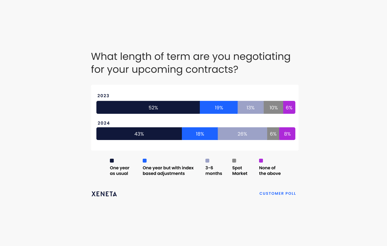2023 started with sluggish consumer demand and rising inflation. With easing port congestion, idle fleet and capacity management have now become significant supply-chain issues.
But as the ocean freight market continues to weaken, are there any opportunities for you to save money? Can you optimize supplier relationships to ensure the best spot or long-term deals on all your trades?
Watch Peter Sand, chief analyst at Xeneta and Emily Stausbøll, market analyst at Xeneta, during the latest State of the Ocean Freight Market webinar to learn how your freight strategy can withstand these turbulent times.
Note: Xeneta customers are invited to join the upcoming exclusive customer session. To learn more, please visit your 'Xeneta Customer Hub.'
Key Webinar Takeaways:
- Carriers are blanking 55% of all sailings— how can shippers mitigate this?
- The potential impacts of Chinese New Year and related domestic travel
- Downward trending volumes and expected numbers in 2023
- Spot & long-term ocean freight rates on top trade lanes
Ocean freight rates across major trade lanes
Far East Main to US East Coast Main trade is part of the importing region that has been the center stage for a lot of attention in the past couple of covid years. It saw few wild developments all year around in 2022. The labor negotiations are still ongoing on the US West coast, making a lot of cargo re-direct itself into the US East Coast.
Also, this is where fronthaul meets another fronthaul. North Europe, into the US East coast, has also seen a couple of busy years during the Covid times. The volume that is shipped right now on a global scale has dropped rapidly since September. Xeneta experts believe the trade will continue to see low volume, similar to what we saw in September, October and November last year.
When compared to the previous year, the volumes have dropped between 15 and 25% on main trades. This is definitely a traumatic development, but it is not a surprise. It is a leading indicator of the global container shipping market. The spot freight rates dropped from $12,000 plus priority shipping fees in the first half of 2022.
Until last year, global shippers were asked to pay extra fees on a similar trade above $10,000 per box just to ensure that they got the equipment set aside for the goods and secured shipment out of Asia. Those days, fortunately, are gone now. Also, a huge part of the congestion on a trade like this has now evaporated.
Long-term contracts on the US East Coast
In comparison to other major trades, this trade still has a large spread between spot and long-term rates coming into January.
"Traditionally, on the US East Coast, most new contracts start a little bit later in the year than, for example, on trade into Europe. So we would expect long-term rates to come down even further when a lot of those new contracts come in April or May," noted Emily.
Currently, there's a limited number of new long-term rates that are coming into this benchmark. It is important to note that Xeneta's indicator takes an average of the contracts signed within the past three months hence leaving the difference between rates coming from January.
Rates in January 2023 are much lower than rates coming from the end of last year, which are included in this three-month rate. So there's definitely more room to fall. If we look at some of the other trades, which are further along in their tendering process, that spread is much smaller.
Peter referred to it as a negative spread between long-term and short-term right now. In a normal market or pre-pandemic years, we often saw the spot rates trade above the long-term contracts, which was also the case in the first half of 2022.
But as demand has evaporated, the long-term rates seemed to be more rigid in coming down. We also see carriers pushing back on requests from shippers to renegotiate rates on long-term contracts signed in the most recent months or quarters.
But then again, what should a smart shipper do in such a situation?
Peter suggests having a renegotiation clause included in your long-term contract or signing a shorter-term contract. This will ensure that you do not get yourself entangled in a 12-month agreement.
You can also leverage Xeneta data to understand at what rate everyone is procuring freight in the market. You can also avoid paying more than your competitors down the line.
Freight rate data transparency is especially useful if you're working in one of the low-margin industries. They are now finding their way back into container shipping and ocean freight following the pandemic years. For low-margin industries, a lot of cargo had moved out of the market, as $12,000 per box is not sensible for a low-profit or low-margin product.
How are carriers reacting to the declining demand?
For Asia to North Europe Main, carriers' schedules are still open as per in week 9, week 10, and week 11 when looking at the capacity and blanked sailings in the Xeneta platform. The Chinese New Year was in the week of Week 4. The capacity would have sailed, if demand was there. However, due to low demand, carriers are adjusting by blanking sailings.
Asia to US East Coast also saw capacity being blanked in week 5. Fifteen sailings were blanked in week five with a total capacity equivalent to 149,000 TEUs. Only 75,000 would sail during that week from Asia to US East Coast as carriers try to match evaporating demand with capacity. Also, on Asia to US west Coast, most blanks took place in week five, closer to the Chinese Lunar New Year. Hence, canceling a traditional peak this holiday season.
To really understand the massive scale of blank sailings, it is important to look back to 2019 data instead of just last year.
Looking at these market developments, one might question - what is the right time to conclude tendering. When would be the right time to sign that new long-term contract?
In the current market, usually, there should be no rush to sign any long-term contracts until your freight requirements leave you with no other option. But we've seen some of the new long-term rates coming in that are very close to the spot market price, particularly from the far East into Europe. It is also important to remember that there is a limit to how much further spot rates really can fall. So what are the other available options?
Big saving opportunities for shippers
With declining demand, blanked capacity and easing congestion on either side of the Atlantic, there might be few savings opportunities for shippers on the transatlantic or any of the other main trades.
Below data highlights the savings that are currently available for global shippers, but which trade can offer you the best deal?
%201.png)








